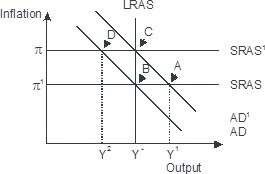If the fluctuations in the economy's real growth rate from year to year are caused primarily by variations in the rate at which aggregate demand increases, then data would show the most rapid inflation occurs when
a. unemployment is the highest, and the lowest inflation occurs when unemployment is the lowest.
b. AS grows most rapidly, and the lowest inflation occurs when AS grows most slowly.
c. AD rises most slowly, and the lowest inflation occurs when AD rises most rapidly.
d. output grows most rapidly and the lowest inflation when output grows most slowly.
d
You might also like to view...
Based on the figure below. Starting from long-run equilibrium at point C, a tax increase that decreases aggregate demand from AD1 to AD will lead to a short-run equilibrium at point ________ and eventually to a long-run equilibrium at point ________, if left to self-correcting tendencies.
A. D; C B. D; B C. A; B D. B; C
Which one of the following is not an example of final goods in national income accounting?
A. Desktop computer purchased by an executive for business use B. Tractor purchased by a construction company C. Lumber and steel beams purchased by a construction company D. Laptop computer purchased by an executive for personal use
A rightward shift in the aggregate demand curve is most likely to result in
A. deflation. B. recession. C. inflation. D. decrease in employment.
If the federal government's expenditures are less than its tax revenues, then
A) the budget is balanced. B) a budget surplus results. C) a budget deficit results. D) No conclusion can be drawn here regarding the budget surplus or deficit without information regarding government purchases versus other outlays.